The Bhopal Gas Tragedy

Hire Arrive
Environment
12 months ago

The Bhopal Gas Tragedy, one of the worst industrial disasters in history, occurred on the night of December 2-3, 1984, in Bhopal, Madhya Pradesh, India. It was caused by a massive leak of methyl isocyanate (MIC) gas and other chemicals from a pesticide plant owned by Union Carbide India Limited (UCIL), a subsidiary of the American company Union Carbide Corporation (UCC). Here's an overview of what happened:
What Happened?
- Gas Leak:
- Around midnight on December 2, 1984, a large amount of water entered one of the storage tanks (Tank 610) containing around 42 tons of MIC.
- The water triggered an exothermic chemical reaction, raising the temperature and pressure inside the tank.
- This led to the rupture of safety valves, releasing a highly toxic cloud of MIC gas into the air.
- Spread of the Gas:
- The gas spread quickly over densely populated areas surrounding the plant.
- Due to its high density, the gas remained close to the ground, causing widespread exposure.
- Immediate Effects:
- Thousands of people woke up coughing, gasping for air, and experiencing severe eye irritation, vomiting, and a burning sensation.
- Many were unable to escape and died in their homes or on the streets.
Casualties
- Immediate Deaths:
- Official estimates suggested around 3,000 deaths within the first few days.
- Long-term Deaths:
- Subsequent estimates indicate that 15,000–20,000 people may have died due to gas exposure over the years.
- Injuries:
- Over 500,000 people were exposed to the gas, leading to chronic health issues such as respiratory problems, neurological disorders, eye damage, and reproductive complications.
Causes of the Disaster
- Negligence:
- Inadequate safety systems and maintenance at the plant.
- Non-functioning safety equipment like the flare tower and scrubber meant to neutralize leaked gas.
- Design Flaws:
- The plant design did not meet adequate safety standards.
- Cost-Cutting:
- Union Carbide had reduced operational costs by understaffing and undertraining workers.
- Lack of Emergency Preparedness:
- No proper disaster management plan was in place to handle a chemical leak of this magnitude.
Aftermath
- Legal Consequences:
- Union Carbide Corporation paid a settlement of $470 million in 1989 after prolonged legal battles, which was criticized as inadequate.
- In 2010, seven former UCIL employees were convicted of negligence.
- Health and Environmental Impact:
- Thousands of survivors suffer from long-term health issues to this day.
- The site remains contaminated, with toxic chemicals polluting the soil and groundwater.
- Activism:
- The tragedy spurred global activism for stricter industrial safety regulations and corporate accountability.
Legacy
The Bhopal Gas Tragedy is a stark reminder of the devastating impact of industrial negligence and inadequate safety measures. It highlighted the need for stringent environmental and safety laws to prevent such disasters in the future.